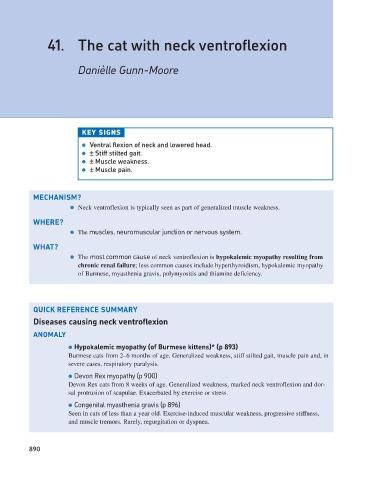Page 898 - Problem-Based Feline Medicine
P. 898
41. The cat with neck ventroflexion
Danièlle Gunn-Moore
KEY SIGNS
● Ventral flexion of neck and lowered head.
● ± Stiff stilted gait.
● ± Muscle weakness.
● ± Muscle pain.
MECHANISM?
● Neck ventroflexion is typically seen as part of generalized muscle weakness.
WHERE?
● The muscles, neuromuscular junction or nervous system.
WHAT?
● The most common cause of neck ventroflexion is hypokalemic myopathy resulting from
chronic renal failure; less common causes include hyperthyroidism, hypokalemic myopathy
of Burmese, myasthenia gravis, polymyositis and thiamine deficiency.
QUICK REFERENCE SUMMARY
Diseases causing neck ventroflexion
ANOMALY
● Hypokalemic myopathy (of Burmese kittens)* (p 893)
Burmese cats from 2–6 months of age. Generalized weakness, stiff stilted gait, muscle pain and, in
severe cases, respiratory paralysis.
● Devon Rex myopathy (p 900)
Devon Rex cats from 8 weeks of age. Generalized weakness, marked neck ventroflexion and dor-
sal protrusion of scapulae. Exacerbated by exercise or stress.
● Congenital myasthenia gravis (p 896)
Seen in cats of less than a year old. Exercise-induced muscular weakness, progressive stiffness,
and muscle tremors. Rarely, regurgitation or dyspnea.
890

